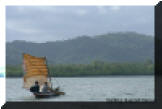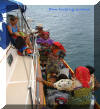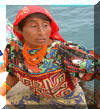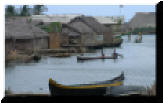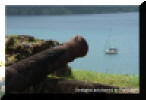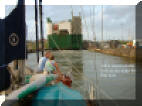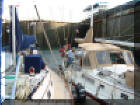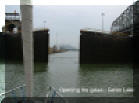Australia Colorado-
Arizona- New Mexico
New Zealand
San Blas & Panama Canal
Bonaire to Cartagena
Florida to Bonaire
The San Blas Islands and The Panama Canal
January - February 2002
Panama is one of the most interesting and exciting places we have traveled. The Kuna Indians of the San Blas islands are among the most traditional indigenous cultures left in the Americas while the nearby Panama Canal is still a marvel of modern engineering despite its approaching 100th anniversary.
The Kunas are a matriarchal society, that is the women own the family wealth and when a young man marries he moves in to help his wife's family household. The women still wear traditional mola blouses and paint their faces with bright red circles and marks on their noses. Molas are wearable art that decorate the women's blouses. They are hand sewn using a reverse appliqué technique and depict ancient designs as well as local flora and fauna. The Kuna houses are small dirt floored and made of sticks with a thatch roof. For food the Kunas paddle or sail their dugout canoes a few miles from the islands where they live to the mainland of Panama where they have small plots of farmland.
So far I have painted a picture for you of a small backward tribal people-- but here is the dichotomy. Each Kuna island has a small airstrip with daily flights to Panama. Most islands have a community telephone and the schools have computers . TV's are not uncommon. The men often work in Panama city. Many Kunas are completely aware of our way of life and have experience of bustling Panama city yet they have made a conscious decision to live they way they do. They are open friendly and wonderfully untouched by much of the world.
Click on any photo to enlarge then click the back arrow to return here
About 5 minutes after the photo on the right was taken Ventana's anchor dragged and she began to go out to sea without us while we were still high on this hill. Fortunately friends on a nearby boat rushed over and re-anchored her.
The Panama Canal
February - April 2002
The Panama canal is still one of the great wonders of the world. Think for a moment about the concept of taking an ocean going sailboat or a giant supertanker across the American continent. Imagine water lifting sailboats or cruise ships high enough to cross the continental divide (which in my home state of Colorado is 13,000 feet above sea level).
The numbers associated with the canal defy imagination. 52,000 gallons of fresh water are used for each transit of the canal and there are 30 transits a day. When the canal was being built they poured 3,000 cubic yards of concrete each day for two and a half years. The Panama canal was begun by the French with surveys as early as 1870 and construction by 1880 and was completed by the Americans in 1914. Thirty four years under construction! More than 22,000 workers died during the French construction period before Malaria and Yellow Fever were conquered. Under the Americans there were over 75,000 workers on the project. In all over 300,000,000 tons of earth and rock were removed to make the canal. Each lock is longer than 3 football fields and the Empire State Building could be laid down inside the locks with room to spare. Each of the giant lock gates are 80 feet tall and weigh 725 tons yet the hinges are so precisely made they are opened with a tiny 40 horsepower motor. The canal was so state of the art when it was built that despite all the miracles science has brought us in the nearly 100 years since its construction there have been only a few very minor changes in the canal.
Our canal transit began in Colon on the Atlantic/Caribbean ocean at 5 am when our canal advisor boarded Ventana. Also with us were our friends from the sailboats Djarrka and Wave Dancer to handle the lock lines and Chris , a budding filmmaker from Lady Starlight to document our adventure. We motored a few miles in darkness but by sunrise we were entering the first lock. Like proceeding into a dark concrete canyon we steered gingerly between the towering lock walls. We were rafted up to the sailboat Surrender and behind the giant car carrier Star Fuji which is among the largest ships on the ocean. Once we entered the lock things began happening very fast as the four lock tenders threw small lines to our boat with monkey fists on the end. To these light lines we tied our stout mooring lines which were then hoisted by the lock keepers and secured to the wall. A few heartbeats later the giant doors were closing noiselessly behind us and then the boats began to dance and jostle as thousands of gallons of fresh water were let into the floor of the lock chamber. Like a slow elevator we watched ourselves rise 27 feet in less than 5 minutes until the towering concrete locks became level with Ventana's decks. As we went up our line handlers took up the slack in the lines to keep us positioned in the center of the lock and away from the rough concrete walls.
When we reached the water level of the next lock the doors silently and smoothly slid open. This was the most tense moment as the giant car carrier in front of us put her engines in gear to move ahead. The propellers are as big around as our whole boat and have the power to easily spin us into the wall. Several months ago two sailboats were dismasted and nearly destroyed when they were crushed under the stern of a large freighter. Fortunately the Star Fuji was not heavily laden and used only half power to get moving. The waters around us swirled and pulled at our lines but our lock handlers were attentive and we stayed fast to the lock walls. We soon repeated the process in the next two locks and within half an hour we motored out onto Gatun Lake.
This lake was one of the largest man made lakes in the world when it was created by flooding the Chagres river valleyand we had a beautiful motorsail across the 20 odd miles of calm water. Along the way we saw monkeys in the trees and watched for the fresh water alligators known to be here. Soon the lake got smaller and smaller as we reach the narrowest part of the Panama canal and the most difficult to construct- the Gaillard cut.
Just before we enter the cut we get a message to halt and wait for a ship heading the other direction with a hazardous cargo. The pilots do not want us to pass him in the narrow constrains of the cut. We don't have a long wait before we see the top of a huge cargo carrier coming from behind the hill followed shortly by the giant bulk of the bow of the ship. It is a class of vessel called a Super Panamax - ships specifically built to the maximum size that can fit through the locks. The locks are 1,000 feet long and 110 feet wide and this vessel is 958 feet long and 106 feet wide. Pulling him into the locks is like parking your car in a garage with one half inch clearance on each side. In addition he has absolutely no view of his own bow. On container ships and many ocean vessels the deck cargo is stacked so high and the wheel house is so far aft that they can see nothing closer to them than 3 miles!!
After we pass the Super Panamax ship we enter the narrow Gaillard cut where we cross the continental divide at 85 feet above sea level then enter the first of the down locks. Here we raft up to a tugboat to go in front of the giant ship transiting with us. The view over our shoulders of the ship's huge bow is one we hope never to see on the ocean. Going down is smooth and in minutes we find ourselves in the mile long lake which separates the first and second down locks. There is a small boat club here where we will spend the next month doing boat projects and getting Ventana ready for her Pacific crossing.
Now as we sit in our cockpit typing this we are only a 150 feet from the locks and we watch the shipping of the world pass off our stern day and night. The size and diversity of the vessels is astounding. On the ocean we always give them a wide berth but here in the safety of the canal we are fascinated to see them so close up. Yesterday morning the girls on their 6 am walk were stopped by canal security and not allowed onto their usual path. Next a helicopter was circling overhead and darting all around our area, then we saw the gray sail of a Trident class nuclear submarine heading our way. Passing just a bit off our stern the US naval vessel entered the locks guarded closely by several navy gun ships. The Panama canal is the only place in the world where Navy commanders must relinquish control of their ships to the Canal Pilots.
In a few weeks we will leave here for our final drop to sea level and the Pacific ocean.
Stay tuned.
Rob & Dee




















